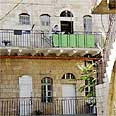
Jenny Ki Tov

Nachlaot
Photo: Dubi Zakai
Let’s start from the end: To my surprise, the Jerusalem neighborhood of Nachlaot, one of the Israeli’s most picturesque areas can be enjoyed from a wheelchair. The beauty and character I remember from my two legged days can still be appreciated now that I sit in a wheel chair.
This kind of tour requires cooperation of everyone involved: The person in the wheelchair willing to deal with sudden twists and turns in the narrow alleyways, roads that are far from paved and the accompanying person not to deviate from the predetermined route.
I was surprised to discover that the route of the tour which took about two hours of constant movement was totally navigational for me except for one stair at the beginning and three stairs which were low but fairly wide in the middle.
Now come the drawbacks as I prepare a second guide for wheelchair bound tourists where I team up with Arnon Bruckstein, a friend who is also a tour guide. We limited our tour to the neighborhoods between Agrippas and Bezalel Streets during which I used a light wheelchair easily maneuverable by a healthy person.
Tour de Capital
Ronit Svirsky
Tour guide Oded Amitai smelled the aroma of delicacies emanating from the local kitchens and decided to give tours in a variety of flavors in the multi-cultural capital
'Heart of the City’
Nachlaot is part of the greater community called ‘Heart of the City’ comprising 32 individual neighborhoods that adjoin one another. Some of them consist of only a few homes or buildings. The entire area is undergoing extensive renovations and preservation, which emphasize the beauty and unique character. Thus anyone whose last visit to the area was a few years ago is in for some surprises.
The 2-2.5 hour walk through the area was conducted on a typical Jerusalem day. It is preferable to begin in the late afternoon when traffic is light and there is parking near the Davidka Square or Clal Center.
The winding route requires strict adherence to the directions laid out where easy wheelchair access to the various sites is assured. Arnon and I did the entire route three times in order to check and double check this.
Yet despite the favorable conditions, I cannot resist asking one naive question: Why are so many of the neighborhood synagogues inaccessible to wheelchair visitors? Why is there no ramp for the disabled to enter more easily? The Jewish religious sites are no different than Christian ones in that regard as described in our first guidebook.
One other thing before we begin: There are no bathrooms in the entire area for the disabled and any potential visitor needs to take that into account.
The route
Let’s start opposite the Gindy paper store on Agrippas St. Cross the street to the arched entrance at number 21 and enter the neighborhood of Sukkat Shalom
Continue straight until you see number 14 where you turn right and find yourself on Mishkanot Street. Look for the lane named for Rabbi Arye Levine. He was a legend of the city; counseled the underground fighters who were imprisoned by the British and was known to all as a righteous man. A long narrow alley traverses a number of the smaller neighborhoods.
Cross Shomron Street to the neighborhood of Mazkeret Moshe. At number 21 turn right to Einayim Lmishpat Street and stop at the beautifully designed gates of the Moroccan synagogue Hesed and Rachamim. Turn left and continue to the Ohel Moshe neighborhood named for philanthropist Moshe Montifiore.
The street features a community water cistern which has since been covered up by the municipality but one can still see its elevated presence. Continue on Carmel Street, passing the park known as mulberry tree park because of the massive tree which lends its shade there as well as mentioned in, ‘Me, and Simone and Little Moises, a song by Yossi Banai about his childhood in the neighborhood.
Further on is Shilo Street. Turn left into the Nachlat Zion and Nachlat Achim neighborhoods. Stop at the impressive synagogue of the Syrian Adas Jewish community at the corner of Shilo and Beersheva Streets. It’s interior is magnificent but difficult for the wheelchair tourist to enter.
Our tour takes us down Beersheva Street, right to Lachish Street, thus avoiding many stairs from where we continue until it meets Geva Street. Turning left and left again, then right we arrive at Ovadia Somech Street. Although we have done some backtracking it is worth stopping at the Beit Yitzhak, the Persian synagogue built in 1894. We turn left and return to the corner where we once again meet Shilo Street. Continue straight until you see a right turn which brings you to the charming Zichron Tuvia neighborhood of one street leading you out to Agrippas and back to where the car is parked.
Jenny Ki Tov is an editor and translator. She is wheelchair bound since being diagnosed with multiple sclerosis. Written with assistance of Schechter Institute of Jewish Studies















